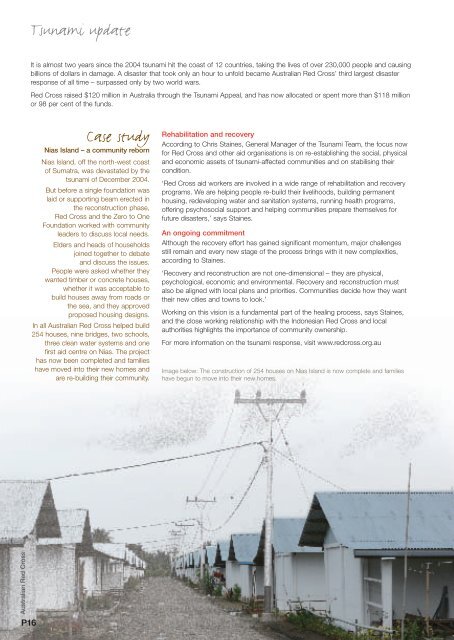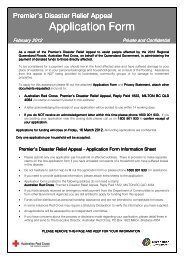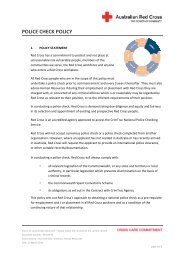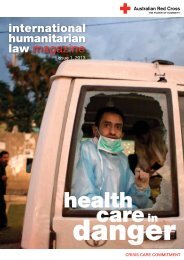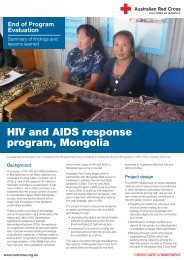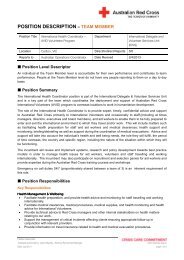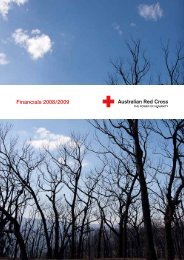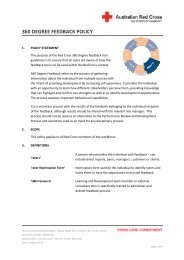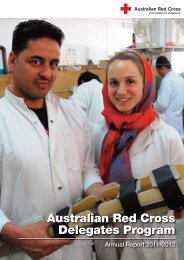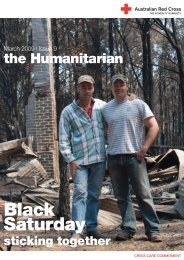Annual report - Australian Red Cross
Annual report - Australian Red Cross
Annual report - Australian Red Cross
You also want an ePaper? Increase the reach of your titles
YUMPU automatically turns print PDFs into web optimized ePapers that Google loves.
Tsunami update<br />
It is almost two years since the 2004 tsunami hit the coast of 12 countries, taking the lives of over 230,000 people and causing<br />
billions of dollars in damage. A disaster that took only an hour to unfold became <strong>Australian</strong> <strong>Red</strong> <strong>Cross</strong>’ third largest disaster<br />
response of all time – surpassed only by two world wars.<br />
<strong>Red</strong> <strong>Cross</strong> raised $120 million in Australia through the Tsunami Appeal, and has now allocated or spent more than $118 million<br />
or 98 per cent of the funds.<br />
Case study<br />
Nias Island – a community reborn<br />
Nias Island, off the north-west coast<br />
of Sumatra, was devastated by the<br />
tsunami of December 2004.<br />
But before a single foundation was<br />
laid or supporting beam erected in<br />
the reconstruction phase,<br />
<strong>Red</strong> <strong>Cross</strong> and the Zero to One<br />
Foundation worked with community<br />
leaders to discuss local needs.<br />
Elders and heads of households<br />
joined together to debate<br />
and discuss the issues.<br />
People were asked whether they<br />
wanted timber or concrete houses,<br />
whether it was acceptable to<br />
build houses away from roads or<br />
the sea, and they approved<br />
proposed housing designs.<br />
In all <strong>Australian</strong> <strong>Red</strong> <strong>Cross</strong> helped build<br />
254 houses, nine bridges, two schools,<br />
three clean water systems and one<br />
first aid centre on Nias. The project<br />
has now been completed and families<br />
have moved into their new homes and<br />
are re-building their community.<br />
Rehabilitation and recovery<br />
According to Chris Staines, General Manager of the Tsunami Team, the focus now<br />
for <strong>Red</strong> <strong>Cross</strong> and other aid organisations is on re-establishing the social, physical<br />
and economic assets of tsunami-affected communities and on stabilising their<br />
condition.<br />
‘<strong>Red</strong> <strong>Cross</strong> aid workers are involved in a wide range of rehabilitation and recovery<br />
programs. We are helping people re-build their livelihoods, building permanent<br />
housing, redeveloping water and sanitation systems, running health programs,<br />
offering psychosocial support and helping communities prepare themselves for<br />
future disasters,’ says Staines.<br />
An ongoing commitment<br />
Although the recovery effort has gained significant momentum, major challenges<br />
still remain and every new stage of the process brings with it new complexities,<br />
according to Staines.<br />
‘Recovery and reconstruction are not one-dimensional – they are physical,<br />
psychological, economic and environmental. Recovery and reconstruction must<br />
also be aligned with local plans and priorities. Communities decide how they want<br />
their new cities and towns to look.’<br />
Working on this vision is a fundamental part of the healing process, says Staines,<br />
and the close working relationship with the Indonesian <strong>Red</strong> <strong>Cross</strong> and local<br />
authorities highlights the importance of community ownership.<br />
For more information on the tsunami response, visit www.redcross.org.au<br />
Image below: The construction of 254 houses on Nias Island is now complete and families<br />
have begun to move into their new homes.<br />
<strong>Australian</strong> <strong>Red</strong> <strong>Cross</strong><br />
P16


